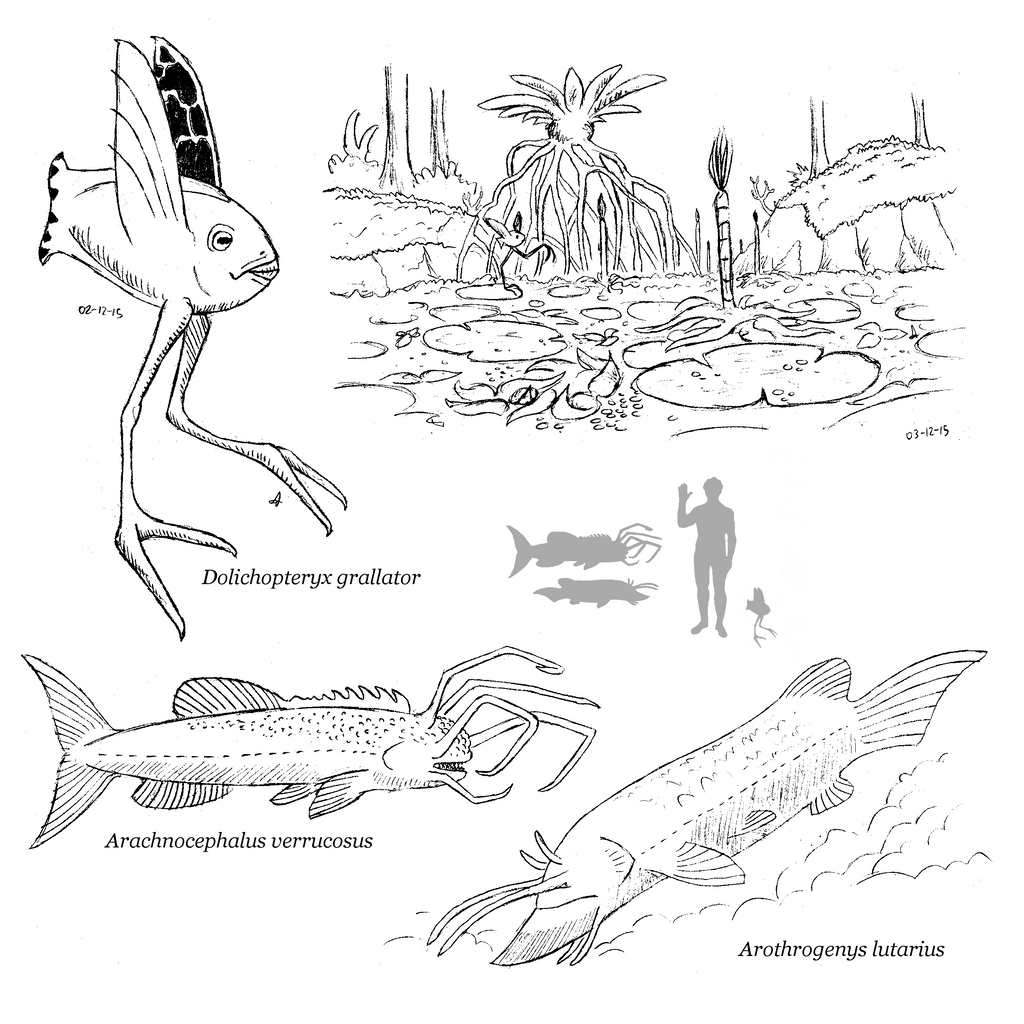HOME | DD
 Concavenator — SftD 7b: Between Land and Water
Concavenator — SftD 7b: Between Land and Water

#futureevolution #erebozoic
Published: 2015-12-07 20:07:27 +0000 UTC; Views: 2721; Favourites: 59; Downloads: 0
Redirect to original
Description
Inhabitants of the lowland cisuralian rivers from my project Settlers from the Deep: a wading raywing that walks on floating plants, and two carnivorous descendants of the african electric catfish of human times.
___
VII. Between Land and Water (part 2)
The high oxygenation of upstream rivers sustains a rich population of freshwater crustaceans, which are in turn consumed by a variety of fish and raywings.
Lowland rivers are wider, slower, richer in mineral nutrients and poorer in oxygen (too poor, in fact, for eftcrocs to grow over half a meter in length). The surface of water is coated in a green film of algae and in the pollen of the swampy vegetation. Here grow thickets of freshwater eelgrass, including reed-like forms that resemble the coastal candlestick plants. Others, the so-called "pondplates", have wide circular leaves that float on the water, tethered to the bottom. Their surface hosts a micro-ecosystem populated by mites, shorebugs, millipedes and pygmy eftsnakes.
The leafwalker (Dolichopteryx grallator) is the largest inhabitant of this floating ecosystem. It's a carnivorous raywing with stilt-like legs, about 40 cm tall. The legs of the front pair and those of the hind pair are partially fused, diverging only in the distal segment, as if they were two limbs each ending in two toes. By spreading its weight on a wide surface, they allow it to walk on pondplates, catching tiny preys with a beak-like dentition. By flapping their small wings they can reduce their effective weight when they search for the sturdier pondplates on which to give birth.
The lowland waters are also the domain of sparkfish, the descendants of the electric catfish (Malapterurus electricus) that lived in african rivers in human times. Being able to breathe through their scale-less skin they survived the period of hypoxy, and thanks to their ability to generate and perceive electric fields they can hunt in the murky waters of the swamps. They spread from Africa to future Cisuralia before the Mediterranean Plateau was established.
Let's examine two examples of sparkfish adaptability: the plough-head sparkfish (Arothrogenys lutarius), a bottom-feeder, and the spider sparkfish (Arachnocephalus verrucosus), a swimming hunter. Both are blind, and search for their preys in the opaque water via electroreception. Despite their name, they don't producevisible electric arcs.
Despite their close kinship, the body of these sparkfish are well adapted to very different lifestyles. The plough-head, as a bottom feeder, has a flattened head with a ventral mouth, surrounded by barbels (much like its ancestor), with large pectoral fins and an enlarged upper lobe of the caudal fin; this helps it swim close to the river bottom, probing the silt. The plough-like lower jaw that gives it its name cuts through the mud, exposing burrowing worms and arthropods to the feeding barbels.
The spider sparkfish, as a pursuing predator, has a spindle-shaped body with a terminal mouth, large dorsal and anal fins for greater stability and a symmetrical caudal fin with a narrow peduncle that provides thrust when swimming. The six barbels have stiffened and articulated into finger-like protrusions that can extend to grab preys. It avoids predation by lying down among fallen weedtree trunks, hidden by the warty skin. Both species prepare nests in the mud in which to spawn.
























